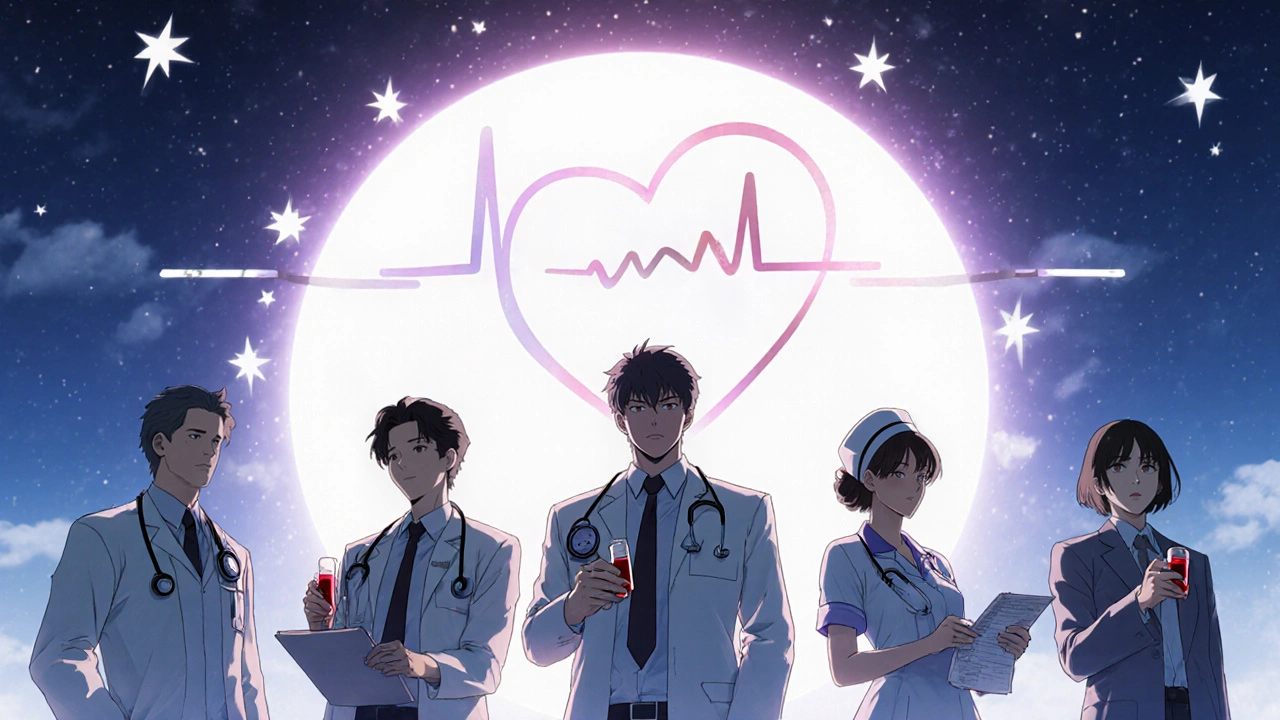Clozapine ANC Monitoring Calculator
Clozapine Monitoring Calculator
This tool helps you understand your monitoring schedule and check if your ANC values are within safe ranges according to current guidelines.
The FDA has officially ended the mandatory REMS for clozapine as of February 24, 2025. This isn’t just a paperwork change-it’s a major shift in how doctors, pharmacies, and patients handle one of the most effective treatments for treatment-resistant schizophrenia. For over a decade, getting clozapine meant jumping through a complex set of federal hoops: certified prescribers, certified pharmacies, monthly blood test reports, and patient re-enrollments. Now? None of that is required anymore. But here’s the catch: the risk hasn’t disappeared. The blood monitoring still matters. The safety rules just changed from government-enforced to doctor-guided.
What Was the Clozapine REMS Program?
The Risk Evaluation and Mitigation Strategy (REMS) for clozapine started in 2015. It was created because clozapine can cause severe neutropenia-a dangerous drop in white blood cells that can lead to life-threatening infections. The FDA had seen this happen before. In the early 1990s, over 300 patients died from agranulocytosis after starting clozapine. So they built a system to stop it. Under the REMS, every step was tracked:- Prescribers had to complete training and get certified through the Clozapine REMS website.
- Pharmacies had to be certified too. If they weren’t, they couldn’t fill the prescription.
- Patients had to enroll in the program and submit monthly blood test results-Absolute Neutrophil Count (ANC)-before each refill.
- ANC had to be above 1,500/μL for most people, or 1,000/μL for those with benign ethnic neutropenia.
- Monitoring was strict: weekly for the first 6 months, biweekly from 6 to 12 months, then monthly after that.
This wasn’t optional. If your ANC dropped below the threshold, or if you missed a report, your pharmacy couldn’t give you your medication. No exceptions. No delays. No mercy.
Why Did the FDA Remove the REMS?
The FDA didn’t remove the REMS because they thought clozapine was safe. They removed it because the system wasn’t working the way it was supposed to. A 2024 FDA review looked at real-world data from the Sentinel System, the Department of Veterans Affairs, and Brigham and Women’s Hospital. What they found surprised even some experts:- Doctors were already monitoring ANC at the recommended rates-even without being forced to report it.
- Patients weren’t getting clozapine because the system was too slow. One study found 30% of eligible patients faced delays or dropped out because of the paperwork.
- Prescribers spent an average of 3.2 hours a week just filing REMS forms.
- Small pharmacies, especially in rural areas, couldn’t afford to stay certified.
- Only 12% of people who could benefit from clozapine were actually getting it.
The FDA realized: the REMS wasn’t preventing deaths-it was preventing access. And the people who needed clozapine the most-those with treatment-resistant schizophrenia, who had tried five or six other drugs and still weren’t stable-were being locked out by bureaucracy.
As Dr. Donna Rolin from the American Psychiatric Nurses Association said, “Ending the REMS is a success for both providers and patients.”
What Changes on the Ground?
If you’re a patient, here’s what’s different now:- You don’t have to enroll in any federal program.
- Your doctor doesn’t need to be certified through a government portal.
- Your pharmacy doesn’t have to check a government database before filling your script.
- You don’t have to mail or upload monthly ANC forms.
But here’s what hasn’t changed:
- Clozapine still carries a Boxed Warning-the strongest warning the FDA can give-for severe neutropenia.
- The prescribing information still says: monitor ANC weekly for the first 6 months, then biweekly, then monthly.
- Your doctor still needs to check your blood counts. Skipping them is dangerous.
The shift is from mandatory reporting to professional responsibility. The FDA trusts doctors to do the right thing. And data shows they’re already doing it.

What About the Risk?
The risk of severe neutropenia hasn’t gone away. It’s still highest in the first 18 weeks. About 0.8% of patients still develop it, according to VA data. But here’s the key: most of those cases happen in people who missed their monitoring. Not because they didn’t know-because the system made it too hard to follow through.Now, with fewer barriers, more patients will start clozapine earlier. And when they do, their doctors will still monitor them closely. In fact, the American Society of Health-System Pharmacists is rolling out new guidelines in Q3 2025 to reinforce best practices. They’re not lowering the bar-they’re removing the red tape so the bar can be reached.
How This Affects Patients and Providers
For patients: Access is faster. You won’t wait weeks because your lab results didn’t get uploaded on time. You won’t get turned away because your pharmacy forgot to renew its certification. You’ll get your medication when your doctor says you’re ready. For providers: The paperwork is gone. No more logging into the REMS portal. No more monthly form submissions. No more re-certification deadlines every two years. That 3.2 hours a week? Now it’s 3.2 hours for patient care.For pharmacies: No more 10-15 minute delays per clozapine script. No more staff training on a system that’s now obsolete. Just follow the prescribing information like you do for every other drug.
One big question remains: Will people skip monitoring now that it’s not mandatory?
Based on the FDA’s own data, the answer is no. Studies showed that even before the REMS was removed, 92% of prescribers were following the ANC monitoring schedule. The program wasn’t improving compliance-it was just making it harder.

What’s Next?
Manufacturers like Novartis are updating clozapine labels to remove all references to the REMS program. That change will be complete by mid-2025. The Boxed Warning stays. The monitoring recommendations stay. The FDA will keep watching through the Sentinel System to make sure no spike in neutropenia cases happens.Industry analysts expect clozapine use to jump 25-30% over the next two years. That’s tens of thousands of people who could finally get the treatment that works when nothing else does. The market for clozapine, which was at $487 million in 2024, is now projected to hit $612 million by 2026.
This isn’t about cutting corners. It’s about removing barriers that were doing more harm than good. The science hasn’t changed. The risk hasn’t changed. But the system finally caught up with the reality: patients don’t need more bureaucracy. They need better access to a drug that saves lives.
What Should You Do Now?
If you’re a patient on clozapine:- Keep getting your ANC checked. Don’t skip it.
- Ask your doctor if they’re still following the standard monitoring schedule.
- Don’t assume the drug is “safe now.” It’s still high-risk. Just no longer high-bureaucracy.
If you’re a clinician:
- Continue ANC monitoring per the prescribing information.
- Use shared decision-making with patients-explain why the monitoring still matters.
- Update your protocols to remove REMS references.
If you’re a pharmacy:
- Remove REMS verification from your workflow.
- Verify that the prescription matches the current FDA-approved labeling.
- Still check for contraindications and drug interactions.
The message is clear: Clozapine is still a powerful tool. It’s still dangerous if misused. But it’s no longer held hostage by a system that was meant to protect it-and ended up blocking it.
Is clozapine still dangerous after the REMS removal?
Yes, clozapine still carries a serious risk of severe neutropenia and agranulocytosis. The Boxed Warning remains on all labels. The difference now is that monitoring is guided by medical best practices, not federal enforcement. Skipping blood tests is still dangerous.
Do I still need to report my ANC results to the FDA?
No. The mandatory reporting system is gone. You don’t need to submit ANC results to any federal registry. Your doctor will keep your results in your medical record, but there’s no longer a government database to report to.
Can any pharmacy fill a clozapine prescription now?
Yes. Pharmacies no longer need special certification to dispense clozapine. As long as the prescription is valid and follows current FDA labeling, any licensed pharmacy can fill it. This is especially helpful in rural areas where access was previously limited.
What if my doctor stops monitoring my ANC?
If your doctor stops monitoring your ANC, speak up. The FDA and major medical groups still strongly recommend weekly, biweekly, and monthly monitoring based on treatment duration. Even without a legal requirement, skipping blood tests puts you at risk. Ask for a copy of the prescribing information-it still lists the monitoring schedule.
Will clozapine become easier to get now?
Yes. With the REMS removed, delays caused by paperwork, certification lapses, and pharmacy rejections should drop significantly. Experts predict a 25-30% increase in new clozapine starts over the next two years, especially among patients who were previously denied access due to administrative barriers.
